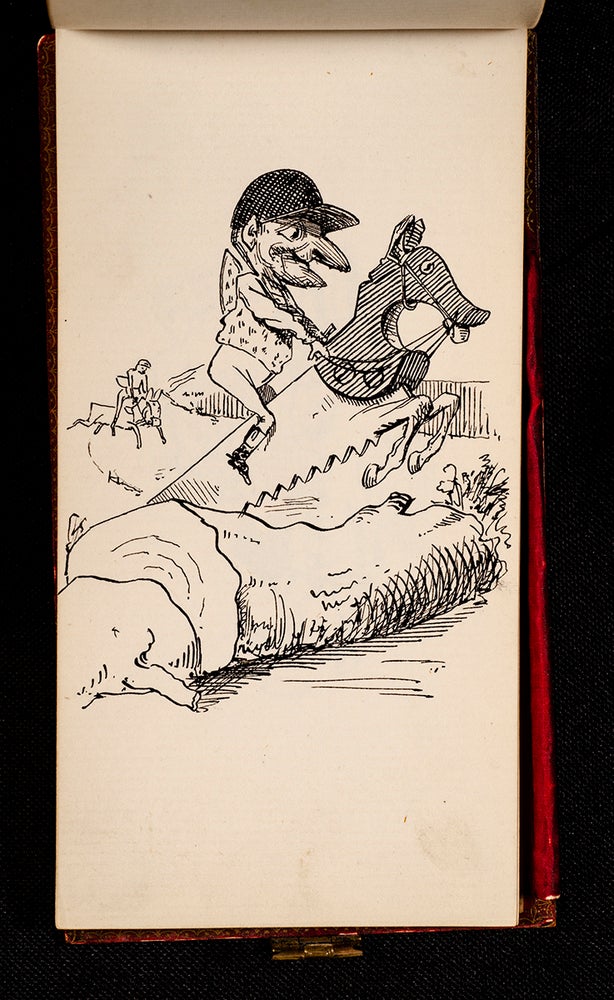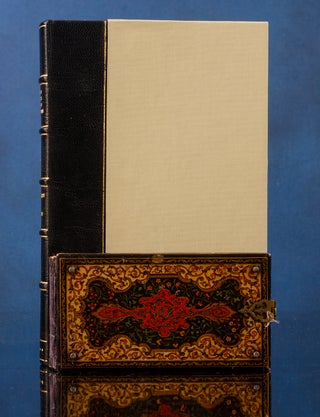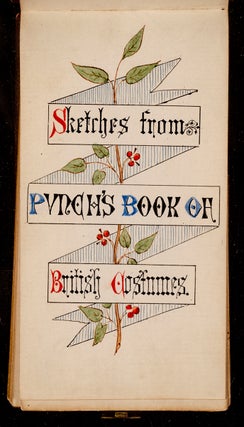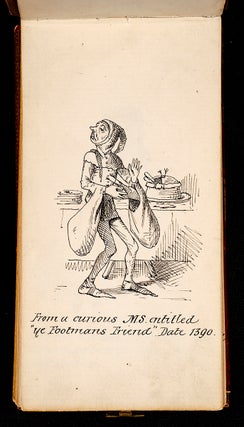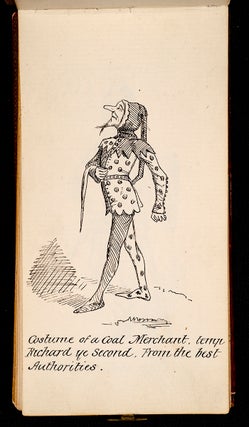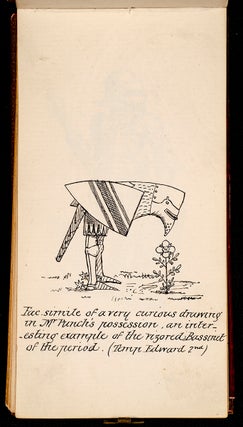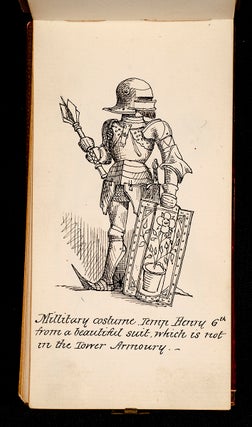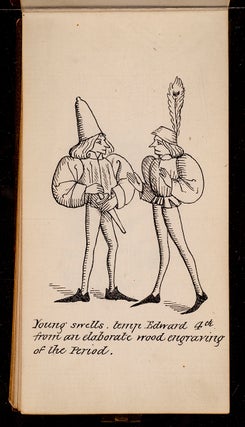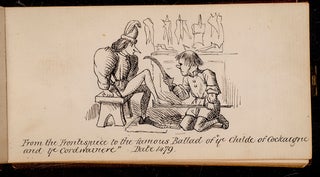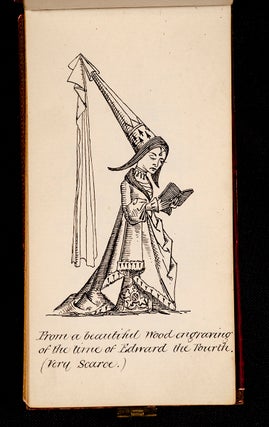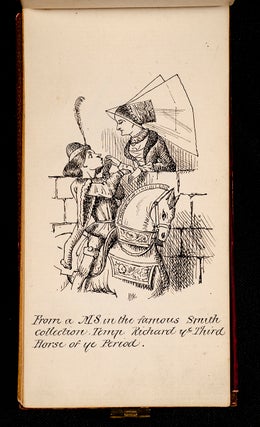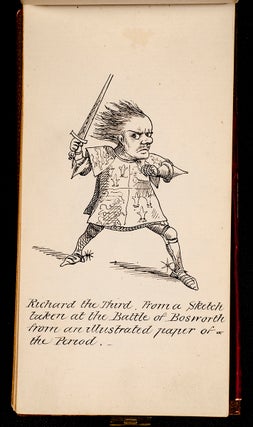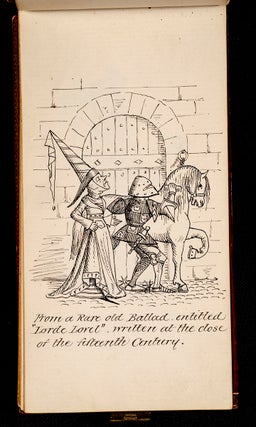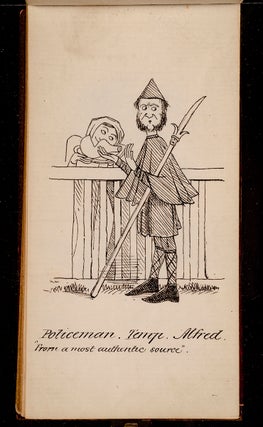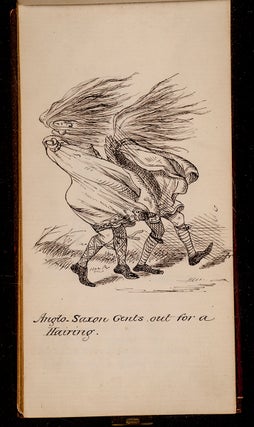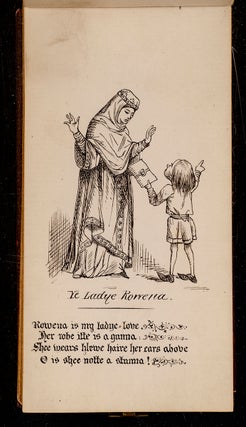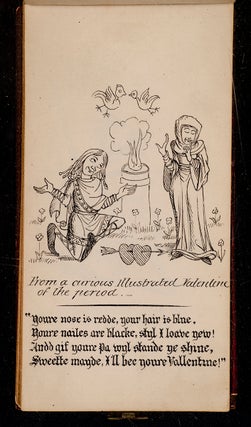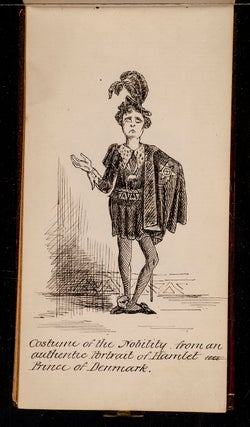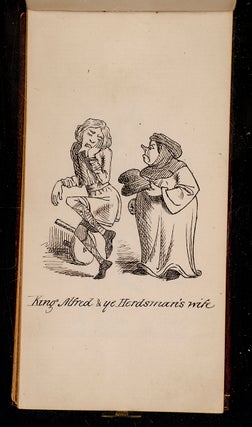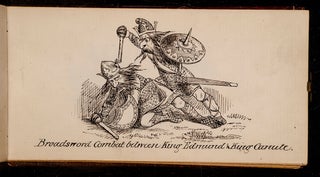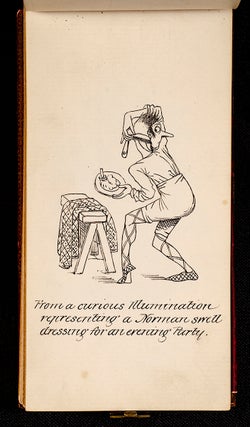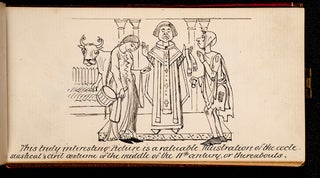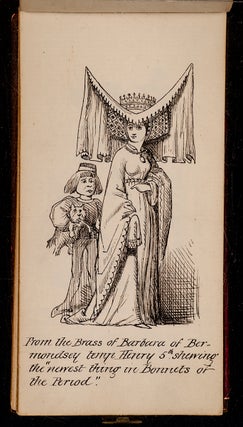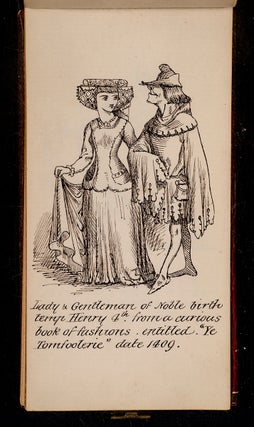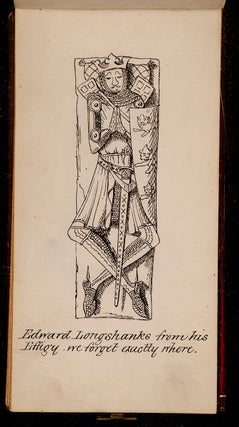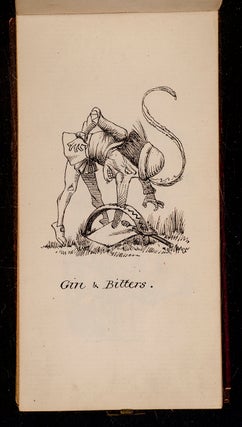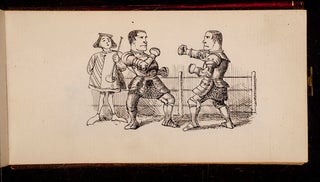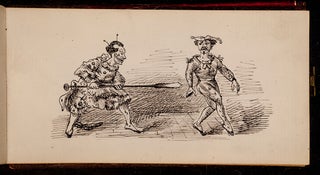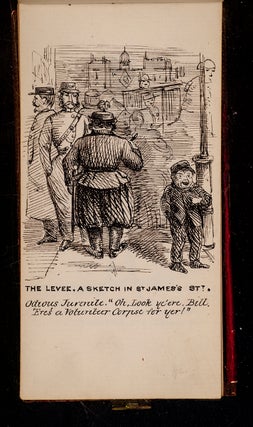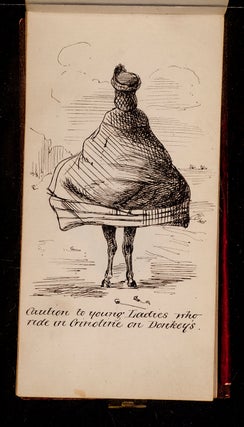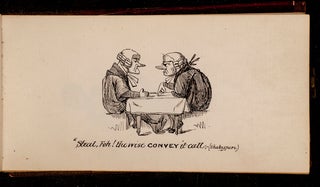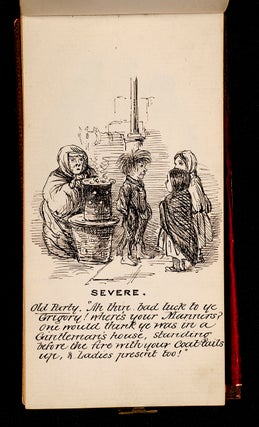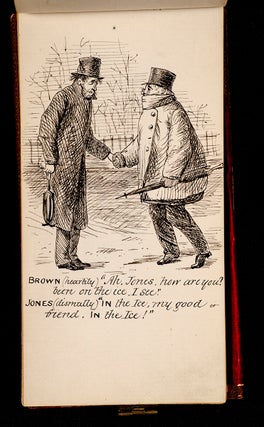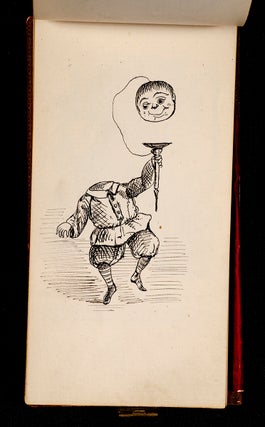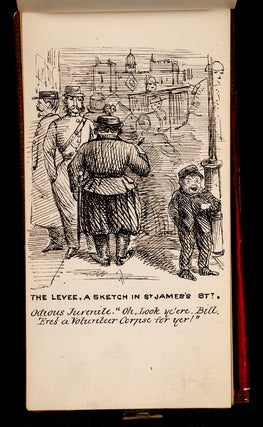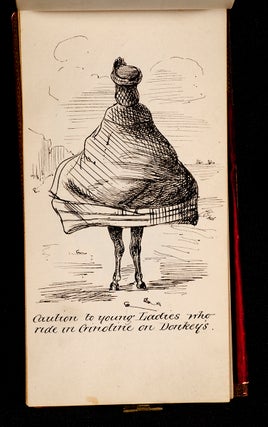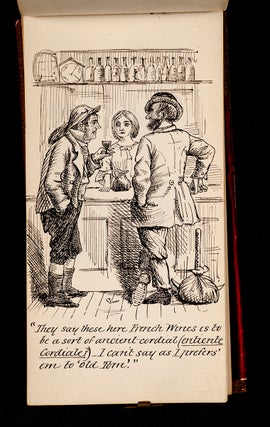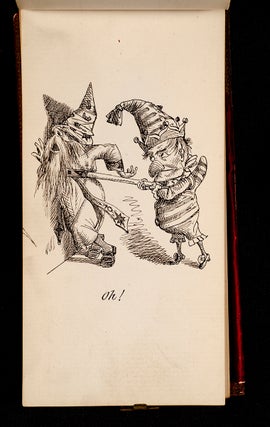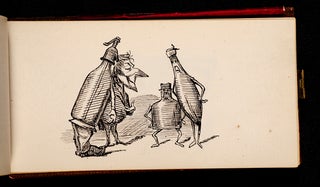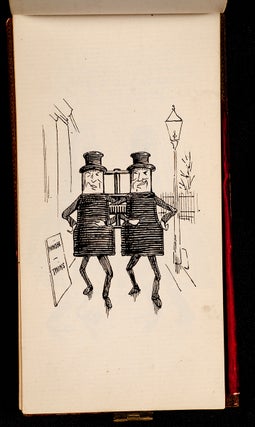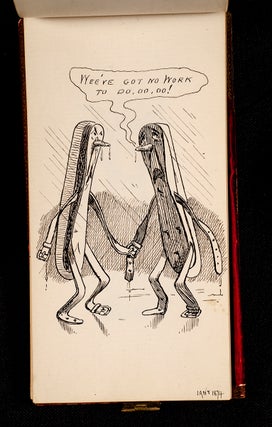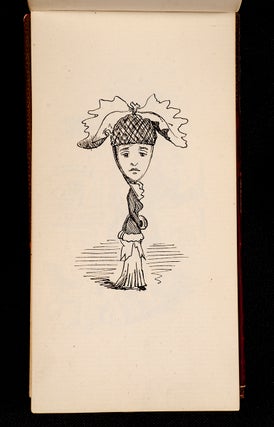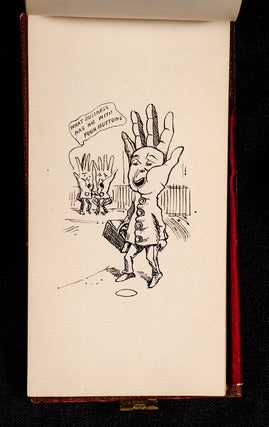Sketches from Punch's Book of British Costumes
London: , 1859. Item #05184
Fifty-Nine Original Pen & Ink Drawings for Punch
By Edward Linley Sambourne
SAMBOURNE, Edward Linley. Sketches from Punch's Book of British Costumes. An Album of Fifty-Nine Original Pen and Ink Satirical Cartoons from Punch Magazine. [London], ca. 1874.
Oblong twelvemo (3 x 5 1/2 inches; 75 x 140 mm.). Hand colored manuscript title-page and 59 original pen and ink hand-drawn satirical cartoons after images produced in Punch magazine, one dated January 1874.
A fine Persian style lacquer 'wallet' binding ca. 1874, original purple velvet spine expertly restored, original silver clasp. Housed in a red felt lined quarter black morocco over pale green cloth clamshell case, spine with five raised bands, ruled and lettered in gilt in compartments.
The detailed pen and ink drawings depict a selection of costumed characters - including a Coal Merchant, Peter of Pimlico (1380), various Kings of England - including Edward II (1284-1327), Edward IV (1367-1413), Henry VI (1421-1471), Richard III (1452-1485), Henry VII (1457-1509), King Alfred (848/9-899), King Edmund (990-1016), Henry V (1386-1422), Henry IV (1367-1413), Henry VI (1421-1471), Richard the Third at the Battle of Bosworth (1485), several Anglo-Danish related illustrations (c.1016), and concludes with some miscellaneous sketches used in Punch, several of which are untitled.
Edward Linley Sambourne (1844-1910), “English draughtsman, illustrator and designer, was born in London, on the 4th of January 1844. He was educated at the City of London School, and also received a few months’ education at the South Kensington School of Art. After a six years' ‘gentleman apprenticeship’ with John Penn & Son, marine engineers, Greenwich, his humorous and fanciful sketches made surreptitiously in the drawing-office of that firm were shown to Mark Lemon, editor of Punch, and at once secured him an invitation to draw for that journal. In April 1867 appeared his first sketch, ‘Pros and Cons,’ and from that time his work was regularly seen, with rare exceptions, in the weekly pages of Punch. In 1871 he was called to the Punch ‘table.’ At the beginning he made his name by his ‘social’ drawings and especially by his highly elaborated initial letters. He drew his first political cartoon, properly so-called, in 1884, and ten years later began regularly to design the weekly second cartoon, following Sir John Tenniel as chief cartoonist in 1901. Examples of his best work in book illustration are in Sir F.C. Burnand’s New Sandford and Merton (1872), and in Charles Kingsley’s Water Babies (1885), which contains some of his most delicate and delightful drawings. The design for the Diploma for the Fisheries Exhibition (1883) is of its kind one of the most extraordinary things in English art. As a political designer, while distinguished for wit and force, he was invariably refined and good-humoured to the uttermost; yet it is essentially as an artist that he takes his highest place. He died on the 3rd of August 1910. See M.H. Spielmann, The History of Punch (London, 1895)” (Encyclopædia Britannica, Eleventh Edition).
Punch
In 1861 Sambourne was apprenticed to John Penn & Son, marine engineers of Greenwich. Initially he worked under the founder's son, John Penn Jr, but was moved to the drawing office when his employer discovered his aptitude for draft drawing. In his spare time Sambourne continued to draw caricatures and study the great graphic artists such as William Hogarth and Albrecht Dürer. One version Sambourne recounts about the events leading to his introduction to Punch's editor Mark Lemon is that his friend and fellow employee at Penn's, Alfred German Reed, showed one of his sketches to his father, the theatrical impresario Thomas German Reed. At his son's urging Thomas passed the drawing on to Mark Lemon. Lemon was sufficiently impressed by the sketch that he encouraged Sambourne to take art lessons and consult the engraver Joseph Swain about drawing on wood. Pleased with the results, Lemon published a drawing by Sambourne in the 27 April 1867 issue of Punch. This was an initial letter 'T' showing the politician John Bright striking a quintain.
Initially employed on a casual basis by Lemon, Sambourne was asked to supply the decorated initial letters that stood at head of articles, stories and poems incorporating the first letter into a fanciful design. Between 1867 and 1874 Sambourne contributed 350 initial letters. Although Sambourne's distinctive style emerged only slowly, he became a regular staff member of Punch in 1871. At the beginning he made his name by his "social" drawings while continuing to provide his highly elaborated initial letters. He drew his first political cartoon, properly so-called, in 1884, and ten years later began regularly to design the weekly second cartoon. At the end of John Tenniel's long occupancy in 1901, he became the magazine's chief principal cartoonist. Unusually for a black and white artist, Sambourne used a huge library of photographic images to give accuracy to his work, which was characterized by a vivid and decisive linearity as well as an artistic inventiveness that took his images far beyond the simple concept of a cartoon or "comic cut". The quality of his work for Punch was acknowledged by the Royal Academy, which exhibited his drawings over a 20-year period.
While his work for Punch occupied most of his energy, it was not Sambourne's only source of income, as he would often accept commissions for individuals, books, magazines and advertisements.
These include:
Military Men I have met ..., Edward Dyne Fenton, 1872
Our Autumn Holiday on French Rivers ..., James Lynam Molly, 1874
Our Holiday in the Scottish Highlands, Arthur à Beckett, 1876
The Royal Umbrella. [A tale.] ..., Alfred Frederick Pollock Harcourt, 1879
The Modern Arabian Nights, Arthur a' Beckett, 1877
Poems of Edgar Allan Poe, 1881
The Water Babies, Charles Kingsley, 1885
Sherryana, F. W. Cosens, 1886
Friends and Foes from Fairy Land, Edward Knatchbull-Hugessen, 1886
The Green Above The Red: More Blarney Ballads, Charles L. Graves, 1889
The Real Adventures of Robinson Crusoe, F. C. Burnand, 1893
The Drawings:
Title-Page: Sketches from Punch’s Book of British Costumes.
1. From a curious M.D. entitled “ye Footmans Friend”. Date 1390.
2. Costume of a Coal Merchant, temp Richard ye Second. From the best Authorities.
3. From the famous Effigy of Peter of Pimlico. Date 1380.
4. Fac. Simile of a very curious drawing in Mr. Punch’s possession, an interesting example of the rigored Bassiment of the period. (Temp Edward 2nd).
5. Millitary costume Temp Henry 6th from a beautiful suit, which is not in the Tower Armoury.
6. From a curious M.S. entitled “ye Gonne, and howe to use itt”.
7. Young swells, temp Edward 4th from an elaborate wood engraving of the period.
8. From the Frontispiece to the famous Ballad of “ye Childe of Cockaigne and ye Cordwainere”. Date 1479.
9. One of “The men in Armour” in a choice old Picture of “ye Lord Mayor his showe” in 1480.
10. From a beautiful wood engraving of the time of Edward the Fourth. (Very scarce).
11. From a M.S. in the famous Smith collection. Temp Richard ye Third Horse of ye Period.
12. Richard the Third. From a Sketch taken at the Battle of Bosworth from an illustrated paper of the Period.
13. From a Rare old Ballad entitled “Lorde Lorel”. Written at the close of the fifteenth century.
14. Fluted Armour temp Henry the Seventh from a suit in Mr. Punch’s collection.
15. Captain of Heary Dragoons temp Henry the Eighth with the Steet Peticoat of those days.
16. Anglo Saxan Laundress from a choice MS. Kindly lent by Mr. Jones.
17. Policeman temp. Alfred. “From a most authentic source”.
18. Anglo-Saxon Gents out for a Hairing.
19. Ye Ladye Rowena.
20. From a curious illustrated Valentine of the period.
21. Anglo-Danish Jack Tar. Dancying ye Hornpyppe.
22. Costume of the Nobility from an authentic Portrait of Hamlet Prince of Denmark.
23. King Alfred & ye Herdsman’s wife.
24. Military costume from a rude drawing on the fly lea of an ancient Danish spelling book.
25. Broadsword Combat between King Edmund & King Canute.
26. Exit of the Danes.
27. From a curious Illumination representing a Norman swell dressing for an evening party.
28. This truly interesting Picture is a valuable Illustration of the ecclesiastical & civil costume of the middle of the 11th century, or thereabouts.
29. Robert Shortshanks, Duke of Normandy from Mr. Punch’s collection of historical Portraits.
30. From the Brass of Barbara of Bermondsey temp Henry 5th shewing the “newest thing in Bonnets of the Period”.
31. Lady & Gentleman of Noble birth temp Henry 4th from a curious book of fashions entitled “Ye Tomfoolerie” date 1409.
32. Henry the sixth and Queen Margaret. From the original drawing in the Whitefriars Collection, never before engraved.
33. Edward Longshanks from his Effigy, we forget exactly where.
34. Title Page: Miscellaneous Sketches from Punch.
35. Gin & Bitters
36. [Untitled]
37. [Untitled]
38. Severe. Old Party. “Ah thin bad luck to ye Grigory! Where’s your Manners? One would think ye was in a Gin Heman’s house, standing before the fire with your coat-tails up, & Ladies present too!”
39. Brown (heartily) “Ah, Jones. How are you? Been on the ice, I see”. Jones (dismally) “IN the ice, my good friend, IN the ice!”
40. [Untitled]
41. The levee, a sketch in St. James St. Odious Juvenile, “Oh, look ye’ere Bill, ‘Eres’ a Volunteer Corpse for yer!”
42. Caution to young Ladies who ride in Grinoline on Donkeys.
43. “Steal, Foh! The wise convey it call”. (Shakespere)
44. [Untitled]
45. A wet day at the sea-side. Baggs. “Thish rain’ll do a deal o’good Charley”. Blobbs. “O Shirtinly – make water so very plentiful”.
46. “They say these here French Wines is to be a sort of ancient cordial (entiente cordiale?) I can’t say as I prefers ‘em to ‘Old Tom’.”
47. Oh!
48. [Untitled]
49. [Untitled]
50. [Untitled]
51. [Untitled] “Don’t I wish I was as strong as you”
52. [Untitled]
53. [Untitled] “Wee’ve got no work to do, oo, oo!”
54. [Untitled]
55. [Untitled]
56. [Untitled]
57. [Untitled]
58. [Untitled]
59. [Untitled] “What business has he with four buttons”
One of the drawings in particular depicts King Canute defeating King Edmund in a duel (#25), however there is another side to this story...
"From 1013-1014, the Danish King, Sweyn Forkbeard, usurped power in England, displacing the Anglo-Saxon monarch, Æthelred the Unready, and his son, Edmund Ironside. After Sweyn’s death in 1014, Æthelred sailed back to England and was proclaimed king once again by his people. At the same time, Sweyn’s son, Canute, also had a claim to the throne of England. Canute was in a precarious political situation, however, for at the same time that much of England was siding with Æthelred against the Danes, a rival son of Sweyn Forkbeard, by the name of Harald (II) Sweynsen, was simultaneously staking his own claim to Denmark. Thus, unsure about the manpower he could muster or the resources he could access, Canute found himself unprepared for war against the resurging Anglo-Saxons. It would take him about a year to gather enough funds and troops to truly begin campaigning against Æthelred the Unready and Edmund Ironside in 1015 and 1016.
Æthelred the Unready died in early 1016, as a fleet led by Canute was closing in on London. With Æthelred’s death, his crown passed to Edmund Ironside. As his “Ironside” nickname suggests, King Edmund (II) put up a stout defense against Canute’s attempts to reclaim the throne of England. Throughout 1016, Edmund and Canute skirmished and battled in multiple clashes of various intensity, the final of which was said to have been the Battle of Ashingdon or Assandun. After that battle, the rival leaders (or their vassals) tired of war, and a peace meeting was arranged on an island then called Olney or Olanege.
According to the histories of Henry of Huntingdon (c. 1080-1160) and Roger of Wendover (d. 1236), Edmund Ironside and Canute were convinced by their supporters to settle their differences once and for all in a duel. As the story goes, an arena was prepared on the designated island and both monarchs arrived in their best sets of armor. They began their fight with spears at opposite ends of a list, competing in something like a joust, yet the two kings wore such exquisite sets of armor that the spears shattered on impact. Next, the kings unsheathed their blades to continue the duel. The English chroniclers claimed, of course, that Edmund Ironside was the superior of the two in the fight, and Henry of Huntingdon outlandishly claimed that Canute, in a moment of fear, offered Edmund control of Denmark in hopes of stopping the duel. Yet, Canute (in this odd scenario) apparently regained some momentum in the duel, and brought the fight back to a standstill. The peculiar tale concluded with Edmund and Canute ending the duel as friends and they agreed to partition England between themselves.
As you may have guessed, this entertaining but unlikely story is viewed with great skepticism, especially since older sources, such as the Anglo-Saxon Chronicle and the Chronicle of Florence of Worcester, make no mention of a duel occurring during the peace negations between Edmund Ironside and Canute that occurred on the island of Olney or Olanege. Either way, duel or not, Canute would be victorious in the long-run. Edmund Ironside died of illness before the end of 1016, leading to the ascension of Canute as king of all England. Canute would go on to add Denmark and Norway to his realm, and was eventually given the epithet of 'the great.'" (https://thehistorianshut.com/2019/10/20/the-odd-tale-of-a-joust-and-duel-between-edmund-ironside-and-canute-the-great/).
Price: $9,500.00

 I have been in the rare and antiquarian book business for over forty years; my family has been in the rare books business since 1876. Rare books are in my blood.
I have been in the rare and antiquarian book business for over forty years; my family has been in the rare books business since 1876. Rare books are in my blood.
